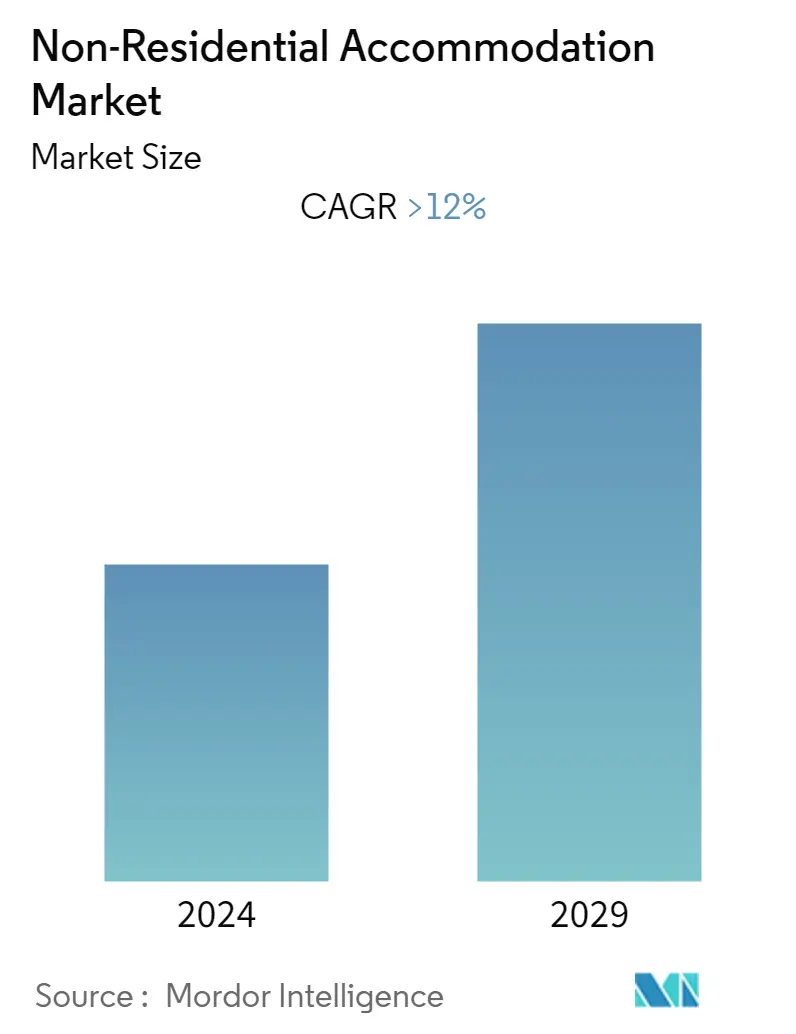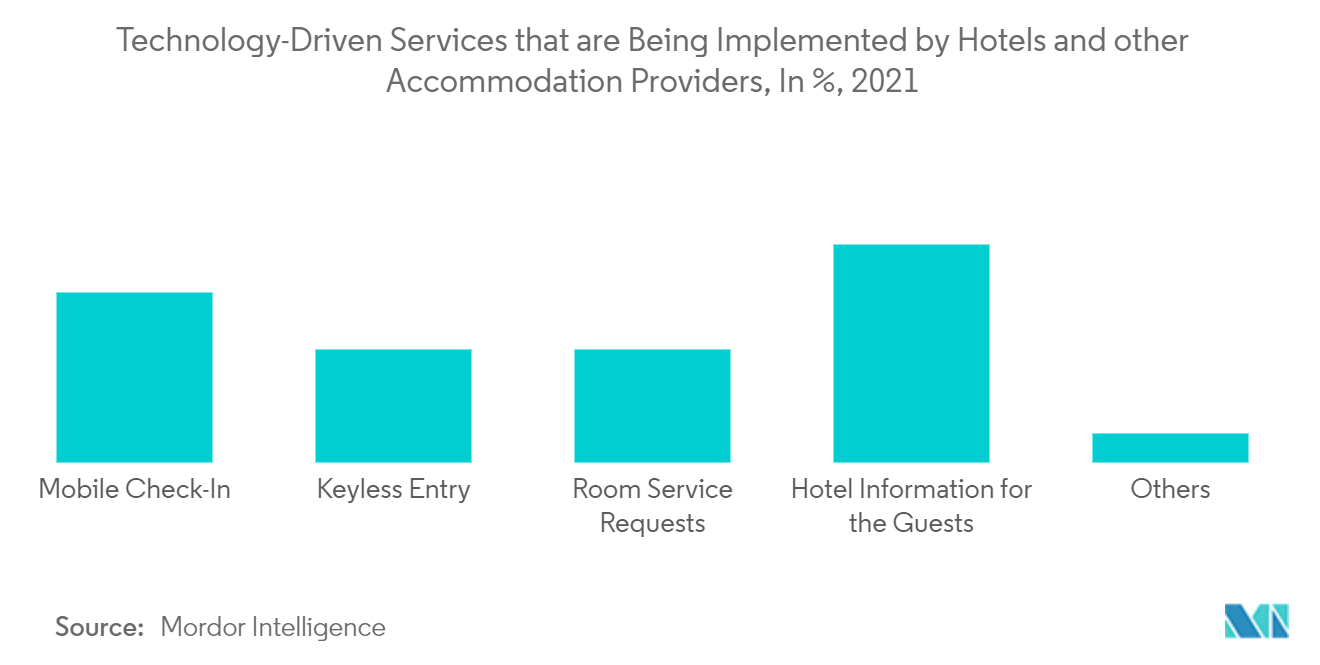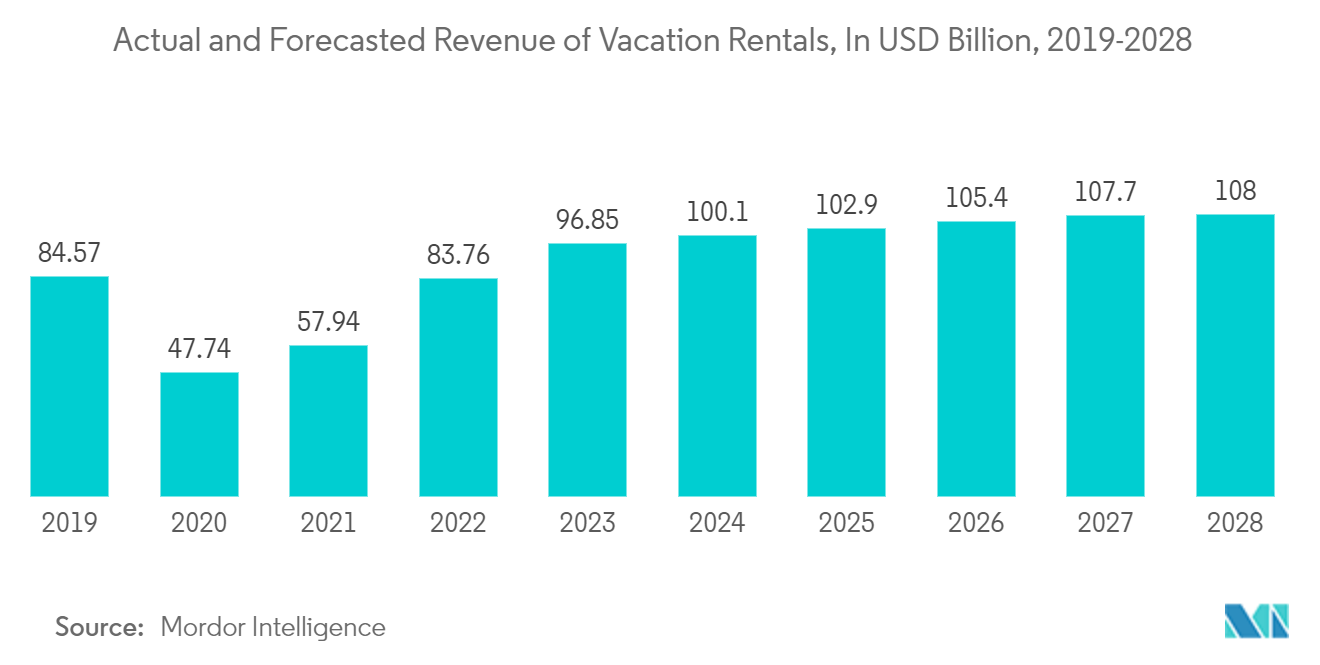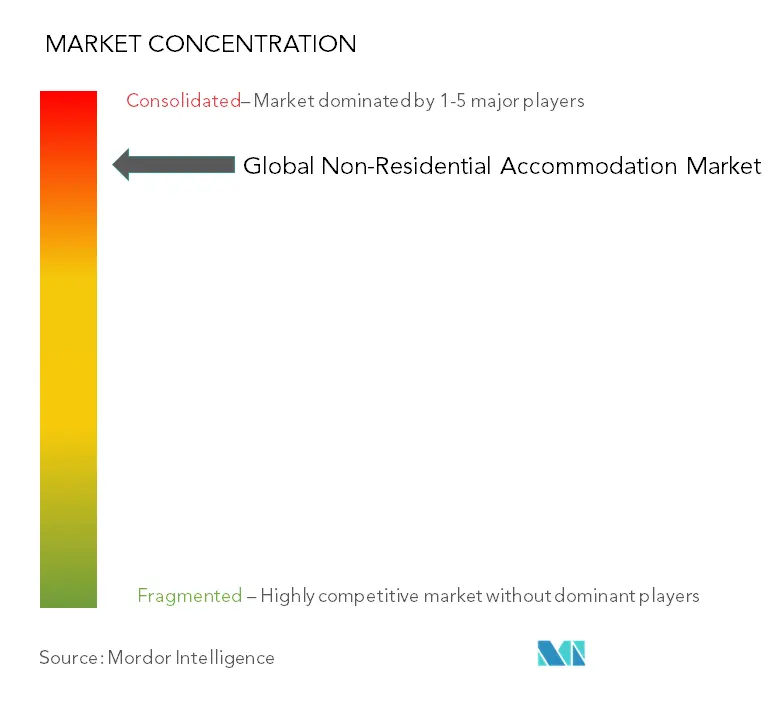Non-Residential Accommodation Market Size

| Study Period | 2019 - 2029 |
| Base Year For Estimation | 2023 |
| CAGR | 12.00 % |
| Fastest Growing Market | North America |
| Largest Market | Asia-Pacific |
| Market Concentration | High |
Major Players
*Disclaimer: Major Players sorted in no particular order |
Non-Residential Accommodation Market Analysis
The Non-Residential Accommodation Market is expected to grow at a CAGR greater than 12% during the forecasted period.
The outbreak of the Covid-19 pandemic had a significant impact on the global non-residential accommodation market. The travel and tourism industry, a major market driver, was severely impacted by the pandemic as countries worldwide implemented travel restrictions and lockdowns to curb the spread of the virus. The hotel industry, in particular, was severely affected by the pandemic, with many hotels experiencing significant declines in occupancy rates and revenues. The pandemic also accelerated technology adoption in the non-residential accommodation industry. Hotels and other accommodation providers implement digital solutions such as mobile check-ins and keyless room access to minimize contact between guests and staff.
The market is driven by increased business travel, tourism, and globalization. The rise of the middle class in emerging economies also contributed to the growth of the non-residential accommodation market, as more people contains the financial means to travel and stay in hotels or other forms of accommodation. The market is highly competitive, with many players operating at various levels of the value chain, from budget to luxury accommodation. Overall, the global non-residential accommodation market is expected to grow over the long term, driven by economic growth, urbanization, and increasing global travel. However, the market's recovery from the pandemic's impact is expected to be gradual, with growth rates varying by region and accommodation type.
Non-Residential Accommodation Market Trends
Technology Driven Services is Driving the Market
Technology greatly impacted the non-residential accommodation market and is expected to continue. Many hotels and other accommodation providers are implementing technology-driven services such as mobile check-in, keyless entry, and digital concierge services to enhance the guest experience and improve efficiency. Many hotels now offer mobile check-in services that allow guests to check in and receive their room keys through their mobile devices. This technology can save guests time and improve the efficiency of the check-in process.
Keyless entry systems allow guests to access their room using their mobile device instead of a physical key. This technology can improve security and streamline the check-in process. Digital concierge services allow guests to request services and information through their mobile devices, such as restaurant recommendations, transportation arrangements, or room service. This technology can enhance the guest experience and provide personalized service. Many hotels now offer in-room technology, such as smart TVs and voice-activated assistants, to provide guests with a more comfortable and convenient stay. These technologies can be used for entertainment, ordering room service, or adjusting room temperature and lighting.
Contactless payment systems, such as Apple Pay and Google Wallet, allow guests to pay for their stay without touching a credit card or using a pin pad. This technology can improve security and reduce the risk of transmitting germs. Technology-driven services are increasingly important in the global non-residential accommodation market, benefiting guests and accommodation providers.

Growing Popularity of Vacation Rentals is Driving the Market
Vacation rentals like Airbnb, HomeAway, and VRBO became increasingly popular among travelers seeking a more authentic and personalized experience. This trend led to increased competition in the non-residential accommodation market, with hotels and other providers offering unique and localized experiences to attract guests. Vacation rentals offer travelers a unique and authentic experience often unavailable in traditional hotels. Staying in a vacation rental allows travelers to immerse themselves in the local culture and experience life like a local.
Vacation rentals are often more affordable than traditional hotels, especially for larger groups or longer stays. In addition, vacation rentals often offer amenities such as kitchens, saving travelers money on dining out. They offer more flexibility than traditional hotels, as guests can often check in and out conveniently. They also offer more privacy and freedom than traditional hotels, as guests can come and go as they please and often have access to more space. The sharing economy gained greater acceptance in recent years as consumers became more comfortable sharing goods and services. It increased the popularity of vacation rentals, as travelers feel more comfortable renting someone else's home or apartment.
The growing popularity of vacation rentals significantly impacted the global non-residential accommodation market, creating new competition for traditional hotels and other accommodation providers. Many hotels and other providers are responding to this trend by offering more unique and localized experiences to attract guests.

Non-Residential Accommodation Industry Overview
The Global Non-Residential Accommodation Market is relatively consolidated, with a few major players dominating the market. The largest non-residential accommodation companies in the world, such as Marriott International, Hilton Worldwide Holdings, InterContinental Hotels Group, and AccorHotels, own and operate numerous hotel brands, covering a wide range of price points and target markets.
Non-Residential Accommodation Market Leaders
-
Marriott International
-
Hilton Worldwide Holdings
-
InterContinental Hotels Group
-
AccorHotels
-
MGM Resorts International
*Disclaimer: Major Players sorted in no particular order

Non-Residential Accommodation Market News
- December 2022: Hilton Announced Continued Expansion of Waldorf Astoria Hotels & Resorts in the Caribbean and Latin America by signing a new hotel in San Miguel de Allende, Mexico.
- October 2022: Marriott International to acquire a city express brand to fuel growth in the affordable midscale segment.
Table of Contents
1. INTRODUCTION
- 1.1 Study Assumptions and Market Definition
- 1.2 Scope of the Study
2. RESEARCH METHODOLOGY
3. EXECUTIVE SUMMARY
4. MARKET DYNAMICS AND INSIGHTS
- 4.1 Market Overview
- 4.2 Market Drivers
- 4.3 Market Restraints
- 4.4 Industry Value Chain Analysis
-
4.5 Industry Attractiveness - Porter's Five Forces Analysis
- 4.5.1 Bargaining Power of Suppliers
- 4.5.2 Bargaining Power of Buyers
- 4.5.3 Threat of New Entrants
- 4.5.4 Threat of Substitutes
- 4.5.5 Intensity of Competitive Rivalry
- 4.6 Insights on Technology Innovations in the Market
- 4.7 Impact of COVID-19 on the Market
5. MARKET SEGMENTATION
-
5.1 By Type
- 5.1.1 Hotels
- 5.1.2 Motels
- 5.1.3 Resorts
- 5.1.4 Vacation Rentals
- 5.1.5 Others
-
5.2 By End User
- 5.2.1 Leisure Travelers
- 5.2.2 Business Travelers
- 5.2.3 Group Travelers
-
5.3 By Distribution Channels
- 5.3.1 Hotel Websites
- 5.3.2 Online Travel Agencies (OTA)
- 5.3.3 Travel Management Companies (TMCs)
- 5.3.4 Corporate Travel Agents
-
5.4 By Geography
- 5.4.1 North America
- 5.4.2 Europe
- 5.4.3 Asia-Pacific
- 5.4.4 South America
- 5.4.5 Middle East
6. COMPETITIVE LANDSCAPE
- 6.1 Market Concentration Overview
-
6.2 Company Profiles
- 6.2.1 Marriott International
- 6.2.2 Hilton Worldwide Holdings
- 6.2.3 InterContinental Hotels Group
- 6.2.4 AccorHotels
- 6.2.5 MGM Resorts International
- 6.2.6 Rewe Group
- 6.2.7 Ctrip.Com International Ltd
- 6.2.8 Starwood Hotels
- 6.2.9 Hyatt Hotels Corporation
- 6.2.10 Four Seasons Hotels and Resorts*
- *List Not Exhaustive
7. MARKET OPPORTUNITIES AND FUTURE TRENDS
8. DISCLAIMER AND ABOUT US
** Subject To AvailablityNon-Residential Accommodation Industry Segmentation
Non-residential accommodation refers to real estate that are not a dwelling, such as a commercial or industrial space, a place of worship, a hotel, a hospital, a school, or a facility owned by the government. Non-residential accommodations include small businesses, commercial agriculture buildings, industrial buildings, and warehouses.
The Non-Residential Accommodation Market is segmented by type (hotels, motels, resorts, vacation rentals, and others), end user (leisure travelers, business travelers, and group travelers), distribution channels (hotel websites, Online Travel Agencies (OTA), Travel Management Companies (TMCs), and corporate travel agents), and geography (North America, Europe, Asia Pacific, South America, and the Middle East). The report offers market size and values in (USD million) during the forecast years for the above segments.
| By Type | Hotels |
| Motels | |
| Resorts | |
| Vacation Rentals | |
| Others | |
| By End User | Leisure Travelers |
| Business Travelers | |
| Group Travelers | |
| By Distribution Channels | Hotel Websites |
| Online Travel Agencies (OTA) | |
| Travel Management Companies (TMCs) | |
| Corporate Travel Agents | |
| By Geography | North America |
| Europe | |
| Asia-Pacific | |
| South America | |
| Middle East |
Frequently Asked Questions
What is the current Non-Residential Accommodation Market size?
The Non-Residential Accommodation Market is projected to register a CAGR of greater than 12% during the forecast period (2024-2029)
Who are the key players in Non-Residential Accommodation Market?
Marriott International, Hilton Worldwide Holdings, InterContinental Hotels Group, AccorHotels and MGM Resorts International are the major companies operating in the Non-Residential Accommodation Market.
Which is the fastest growing region in Non-Residential Accommodation Market?
North America is estimated to grow at the highest CAGR over the forecast period (2024-2029).
Which region has the biggest share in Non-Residential Accommodation Market?
In 2024, the Asia-Pacific accounts for the largest market share in Non-Residential Accommodation Market.
What years does this Non-Residential Accommodation Market cover?
The report covers the Non-Residential Accommodation Market historical market size for years: 2019, 2020, 2021, 2022 and 2023. The report also forecasts the Non-Residential Accommodation Market size for years: 2024, 2025, 2026, 2027, 2028 and 2029.
Non-Residential Accommodation Industry Report
Statistics for the 2024 Non-Residential Accommodation market share, size and revenue growth rate, created by Mordor Intelligence™ Industry Reports. Non-Residential Accommodation analysis includes a market forecast outlook to for 2024 to 2029 and historical overview. Get a sample of this industry analysis as a free report PDF download.



